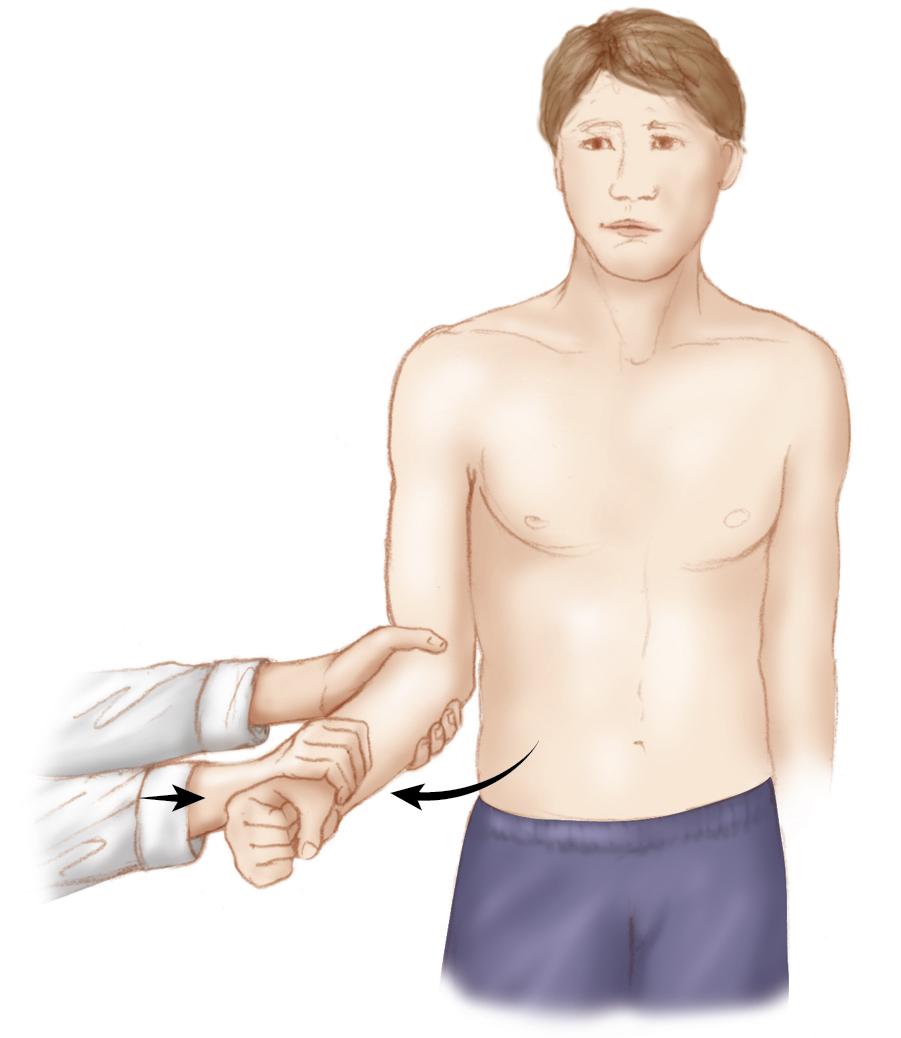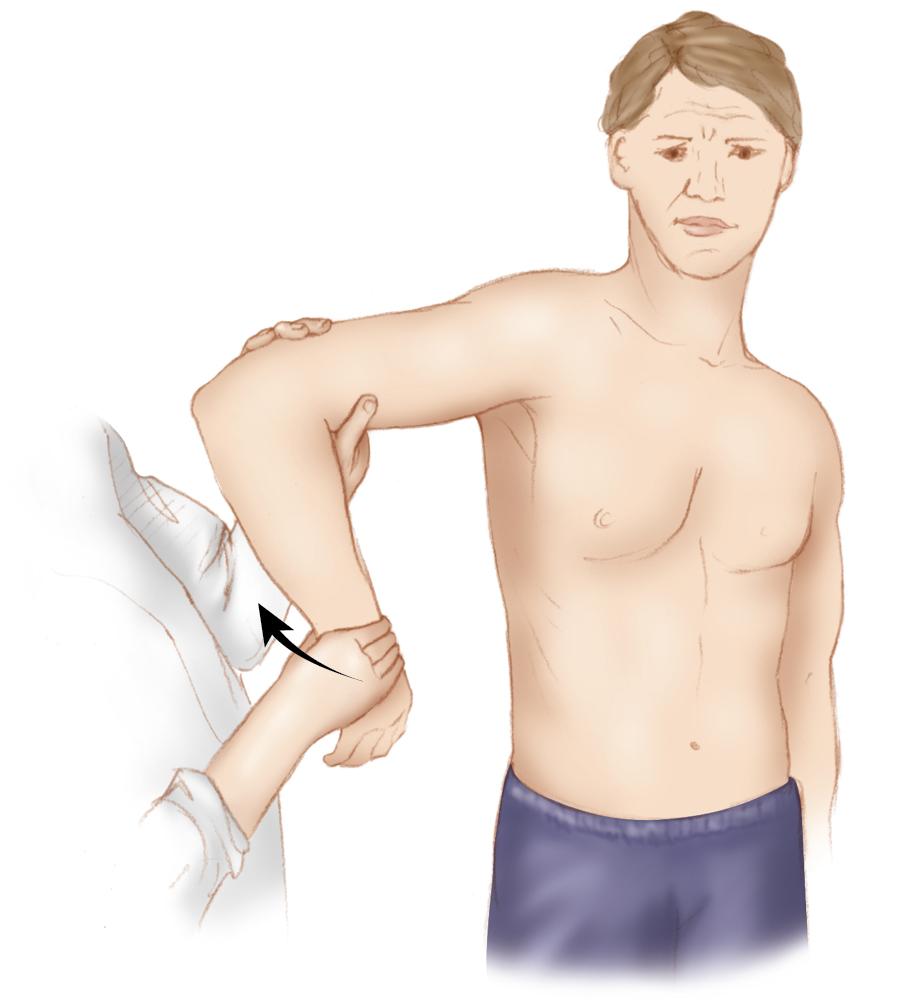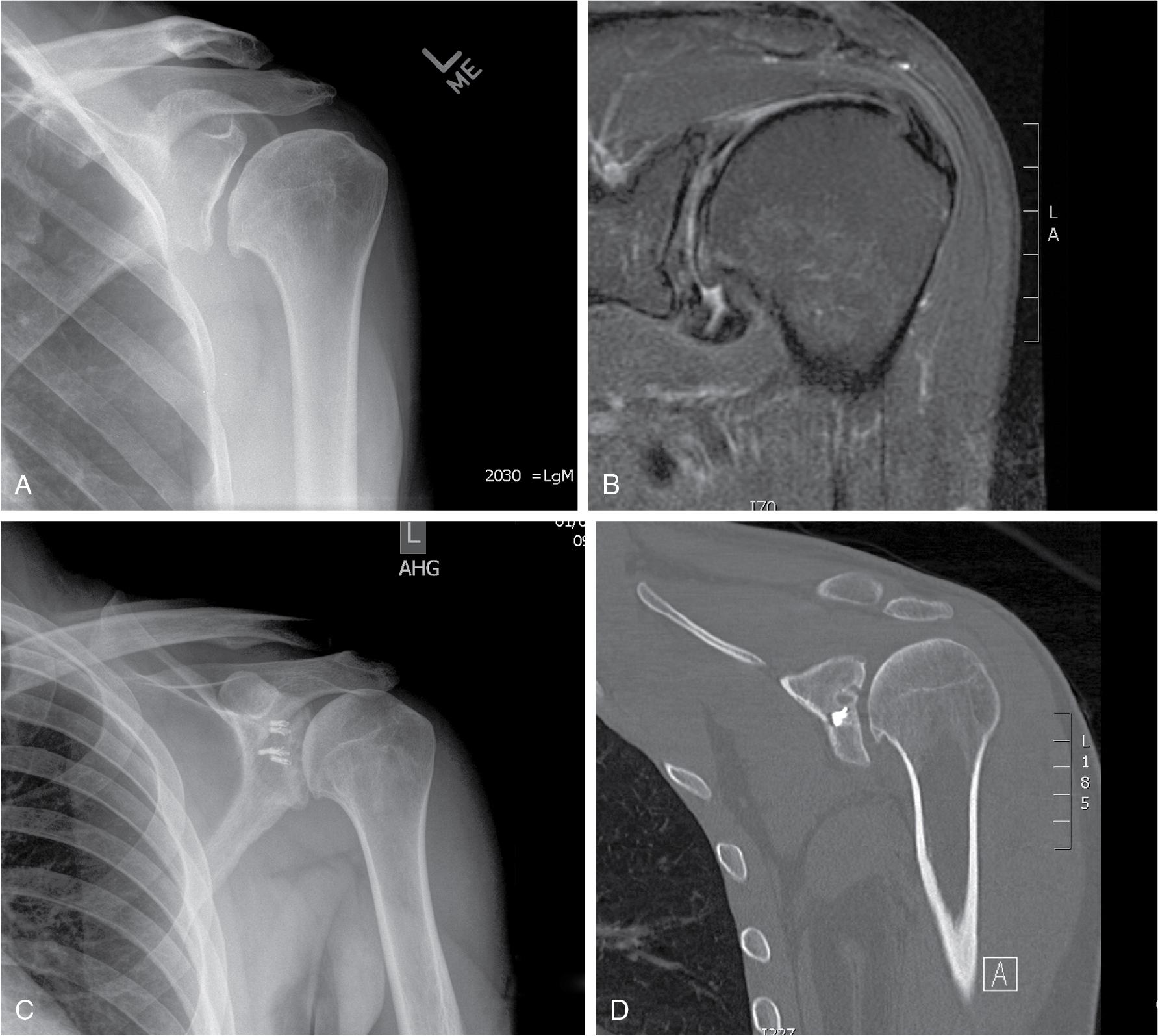Physical Address
304 North Cardinal St.
Dorchester Center, MA 02124
Glenohumeral arthritis in the young and active population remains a challenge.
Chondrolysis is defined as a diffuse, rapid cartilage destruction with narrowing or loss of joint space.
A detailed patient history, examination, and advanced imaging modalities are key to identify the etiology and to develop an individualized treatment strategy.
Nonoperative treatment, including patient education, pharmacotherapy, physical therapy, and intra-articular injections should be considered before surgical options.
Nonarthroplasty options aim to relieve pain, improve function, and delay time to arthroplasty with palliative, reparative, restorative, and reconstructive techniques.
Patient age and desired activity level are important preoperative considerations.
Global location of the defect (glenoid surface, humeral head, or bipolar “kissing” lesions), local location of the defect (central, peripheral), size, depth, and containment of the defect must be thoroughly assessed.
A true anteroposterior and axillary views should be used to assess for subtle glenohumeral joint space changes.
Bony version should be assessed as nonarthroplasty options have limited success if extensive posterior or posteroinferior glenoid bone loss is present.
Posterior humeral translation on the glenoid should be assessed. If posterior subluxation is present, this may indicate worse outcomes with nonarthroplasty options.
Advanced (bipolar) glenohumeral disease can initially be treated with nonarthroplasty options, including capsular release and synovectomy, with less predictable results for interpositional arthroplasty and biologic options.
Isolated chondral lesions of the glenohumeral joint are rare but can be debilitating. It is crucial to identify which lesions are incidental and which are truly symptomatic.
Range of motion deficits may exist as a manifestation of cartilage damage, arthritis, and resultant capsular synovitis, thickening, and contracture.
Arthroscopic debridement, including synovectomy and tailored capsular release (capsulectomy), can help treat range-of-motion deficits.
When performing microfracture, long-handled curettes and awls are used to create clean lesion edges and adequate marrow stimulation.
Autologous chondrocyte implantation has been described for isolated humeral head defects.
Osteochondral autografts and allografts can be used to treat lesions with combined cartilage and bone loss.
Interpositional arthroplasty uses a variety of allograft materials including lateral meniscus, Achilles tendon, and fascia lata.
The lateral decubitus position is preferred for arthroscopic procedures as it allows access to all quadrants of the shoulder.
For open procedures, the beach chair position is recommended as the deltopectoral approach is most frequently used.
A bilateral exam under anesthesia to assess range of motion and stability is recommended before every case.
Comprehensive arthroscopic management can be considered in young patients, whereas arthroscopic capsulectomy is considered the first-line treatment in patients >65 years of age.
Reparative arthroscopic treatment is an alternative for small, contained cartilage lesions that have not eroded into the subchondral plate.
Contraindications: infection, extensive bipolar lesions, bone loss (especially posterior bone erosion).
Surgical pitfalls: not obtaining clean or vertical walls during microfracture, incomplete debridement, incomplete capsular release, axillary nerve injury (closest between the 5- and 7-o’clock positions inferiorly), incomplete pain relief because of extensive disease.
Glenohumeral arthritis poses a challenge in young individuals. Although the elderly can be treated with shoulder arthroplasty with predictable and good clinical outcomes, the results following shoulder arthroplasty are suboptimal in patients under 60 years of age. The pathology in young patients with glenohumeral arthritis is more complex and often a result of secondary causes.
Posttraumatic degenerative changes can occur following proximal humerus fractures, especially following multifragmented fractures involving the joint surface. Malunited proximal humerus fractures may alter the biomechanics of the glenohumeral articulation and accelerate glenohumeral arthritis.
Screw penetration and posttraumatic osteonecrosis of the humeral head is observed in 15% of cases following comminuted proximal humerus fractures, thus resulting in glenohumeral osteoarthritis. Recurrent glenohumeral dislocation and subluxation can also cause posttraumatic osteoarthritis. In a 10-year follow-up of patients treated nonoperatively for anterior shoulder instability, 11% had mild and 9% moderate or severe arthropathy. The prevalence of glenohumeral arthritis increased to 39% at 25 years follow-up. Patients with glenohumeral instability treated with bone block transfer may have glenohumeral arthritis as a result of misplaced hardware and bone blocks after shoulder stabilization surgery.
The term capsuloraphy arthropathy describes altered glenohumeral joint forces resulting from overtightening of the anterior shoulder capsule. The increased load on the posterior glenohumeral cartilage results in accelerated glenohumeral wear of the posterior articular cartilage.
Chondrolysis is a rare condition that results in the rapid degeneration and destruction of cartilage in the shoulder. Suggested risk factors include mechanical damage, such as overt pressure from arthroscopic devices, thermal injury from radiofrequency devices, infection, and chemical injury (infusion of intraarticular anesthetics).
Patients typically report deep shoulder pain, and often the pain is located posteriorly. The pain may also be described as dull or diffuse at rest with stabbing, sharp exacerbation with activity, especially when the arm is brought into the end-range position.
Articular cartilage lesions of the shoulder are often incidental findings discovered during preoperative imaging studies or during diagnostic arthroscopy. If asymptomatic lesions are treated, the true cause of symptoms may be ignored or missed, and the treatment itself may cause further damage to the chondral surface. With this in mind, it is crucial to determine if glenoid or humeral head articular cartilage lesions are truly symptomatic through the gathering of a thorough patient history. In patients with multiple shoulder pathologies and those who have undergone prior operations, it is even more challenging to determine if current articular defects were actually responsible for their previous, preoperative symptoms. In addition, patients with previous shoulder surgery and intra-articular pain pump placement are at risk for the development of postsurgical glenohumeral chondrolysis. Patient history is pivotal in differentiating between osteoarthritis (OA) and chondrolysis. OA is a longstanding pathology presenting with an indolent course including prolonged periods to adapt to a progressive loss of cartilage. In comparison, chondrolysis presents with severe pain and rapid functional loss. Therefore, time to presentation is an important factor in the distinction of chondrolysis from a more passive condition such as OA. During the initial office visit, the clinician should inquire about the following:
Mechanism of injury - traumatic versus insidious onset
Current symptoms - may point to alternative diagnosis
Locking
Clicking
Crepitus
Pain (e.g., rest pain, activity-related pain, night pain)
Stiffness
Inability to use arm above head
Instability
Numbness or tingling
Previous nonsurgical and surgical treatment of the shoulder
Response to prior treatment
Patient’s activity level
Post-treatment goals
Allows the surgeon to address patient expectations, ensuring these are aligned with treatment options and outcomes
Patients with glenohumeral chondrolysis typically have a nonspecific presentation including activity pain, night pain, and motion loss. Popping or clicking sensations and shoulder swelling are often associated with articular cartilage pathology. However, soft-tissue injuries including rotator cuff lesions can also present similarly. Numbness and tingling of the involved extremity are typically not seen in these patients and should direct the clinician to an alternative diagnosis. Patients may also report sudden pain and locking in specific shoulder positions associated with engagement of articular lesions.
A complete bilateral shoulder examination should be performed for every patient being evaluated for symptomatic chondral defects. Range of motion (ROM), strength, sensation, and stability of the affected shoulder are compared with those of the contralateral shoulder. Loss of active or passive motion must be documented and corrected preoperatively. Early identification of stiffness allows time to restore deficits before operative treatment for chondral defects. Special shoulder tests should be performed when necessary to evaluate for comorbidities and to rule out other causes for the patient’s symptoms.
Common, nonspecific physical examination findings in this patient population may include the following:
Tenderness to palpation
Decreased ROM
Decreased forward flexion caused by an inferior humeral head spur.
Decreased external rotation caused by a flattened humeral head.
Decreased external rotation at the side (ERs) can indicate anterior capsular contracture, including the rotator interval, the superior and middle glenohumeral ligament, and the coracohumeral ligament ( Fig. 41.1 ).

Decreased abduction and external rotation (ABER) can indicate anterior and anteroinferior capsule contracture.
Decreased abduction and internal rotation (ABIR) can indicate posterior and posteroinferior capsule contracture ( Fig. 41.2 ).

Decreased abduction (ABD) can indicate inferior capsule contracture and possible involvement of the superior capsule or superior labral anterior-posterior (SLAP) region.
Crepitus with ROM - painless versus painful
Clicking, catching, or locking with ROM
Normal strength and sensation
Imaging studies such as radiographs, magnetic resonance imaging (MRI), magnetic resonance arthrography (MRA), and computed tomography (CT) are routinely used in the evaluation of glenohumeral chondral lesions. Despite advances in imaging techniques, glenohumeral articular surface defects may not be easily seen on plain radiographs or with other advanced imaging modalities, and glenohumeral arthroscopy remains the gold standard for diagnosis. However, imaging remains helpful not only for diagnosis, but also for preoperative planning. Specific planning considerations include the chondral anatomy of the shoulder joint. Normally, the humeral head cartilage is thickest in the center (1.2 to 1.6 mm thick) and thinner at the periphery (less than 1.0 mm thick). In contrast, the glenoid cartilage is thickest along the periphery, tapering centrally to the bare area where it is completely devoid of cartilage. Knowledge of normal anatomy in conjunction with information supplied by imaging studies helps determine the significance of lesions based on their location along the humeral head and/or glenoid surface.
Every patient should undergo a standard radiographic series of the shoulder including an anteroposterior (AP) view, an axillary lateral view, a scapular-Y view, and a true AP view to assess subtle joint space changes. These views are useful in evaluating the joint space for glenohumeral arthritis and may show overt bony abnormalities. Other specific radiographs include the Stryker notch view to evaluate Hill-Sachs lesions and the Garth (apical oblique) view to evaluate glenoid bone loss ( Fig. 41.3 ). The earliest signs of glenohumeral wear are usually in the posteroinferior quadrant of the shoulder and may demonstrate joint space narrowing or subtle posterior joint subluxation ( Fig. 41.4 ).

![Fig. 41.4, (A) True anteroposterior (AP; Grashey) radiograph of a 27-year-old man 6 months after an arthroscopic Bankart repair with an inert plastic (polyetheretherketone [PEEK]) anchor. There is a small osteophyte that is evident only on the true AP view. (B) The anchor eroded through the glenoid, causing linear stripe wear and full-thickness cartilage loss on the humeral head, demonstrated in this arthroscopic image with the arthroscope inserted from the posterior portal. Additional examples of focal humeral head defects demonstrate a concentric humeral head defect (C) and stripe wear (D). Fig. 41.4, (A) True anteroposterior (AP; Grashey) radiograph of a 27-year-old man 6 months after an arthroscopic Bankart repair with an inert plastic (polyetheretherketone [PEEK]) anchor. There is a small osteophyte that is evident only on the true AP view. (B) The anchor eroded through the glenoid, causing linear stripe wear and full-thickness cartilage loss on the humeral head, demonstrated in this arthroscopic image with the arthroscope inserted from the posterior portal. Additional examples of focal humeral head defects demonstrate a concentric humeral head defect (C) and stripe wear (D).](https://storage.googleapis.com/dl.dentistrykey.com/clinical/Nonarthroplastyoptionsforglenohumeralarthritisandchondrolysis/3_3s20B9780323763004000503.jpg)
MRI and MRA are the imaging modalities of choice for the evaluation of glenohumeral chondral surface lesions. In addition to evaluating the articular surface, MRI and MRA can detect subchondral bone changes and concomitant soft tissue ligamentous, labral, and rotator cuff pathology. , T1-weighted fat-suppressed three-dimensional spoiled gradient-echo technique are particularly helpful. Moreover, all sequences should be analyzed through the T2-weighted image (with and without fat suppression).
CT images provide a global evaluation of the glenohumeral joint, and three-dimensional reconstructions add enhanced detail. Although not routinely obtained as part of a workup for suspected glenohumeral arthritis or chondrolysis, CT scans are useful for operative planning in patients requiring more invasive osteochondral reconstruction. CT scans can be especially useful for evaluating full-thickness cartilage defects that include the subchondral bone.
Become a Clinical Tree membership for Full access and enjoy Unlimited articles
If you are a member. Log in here